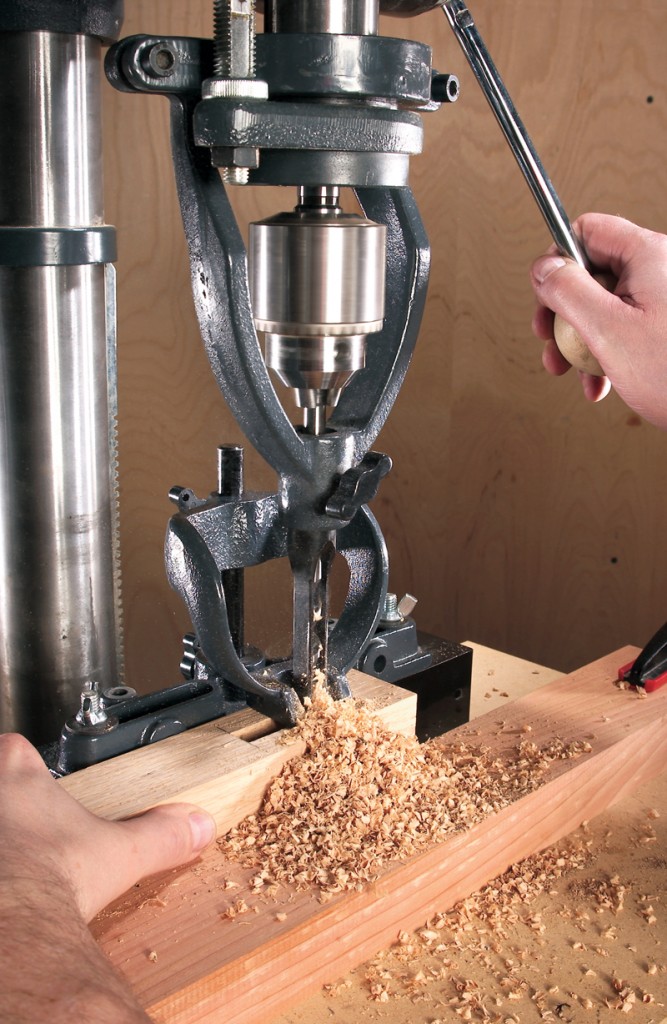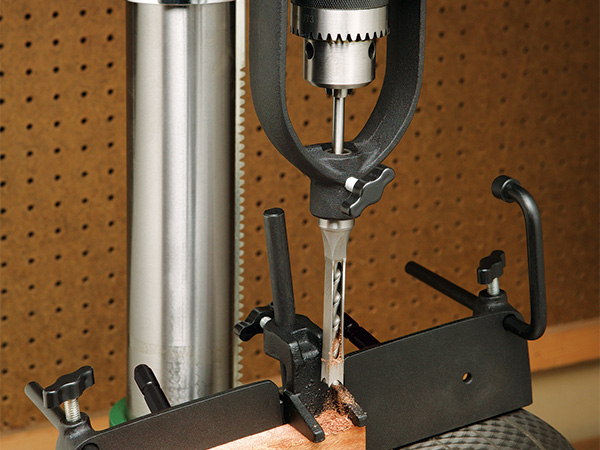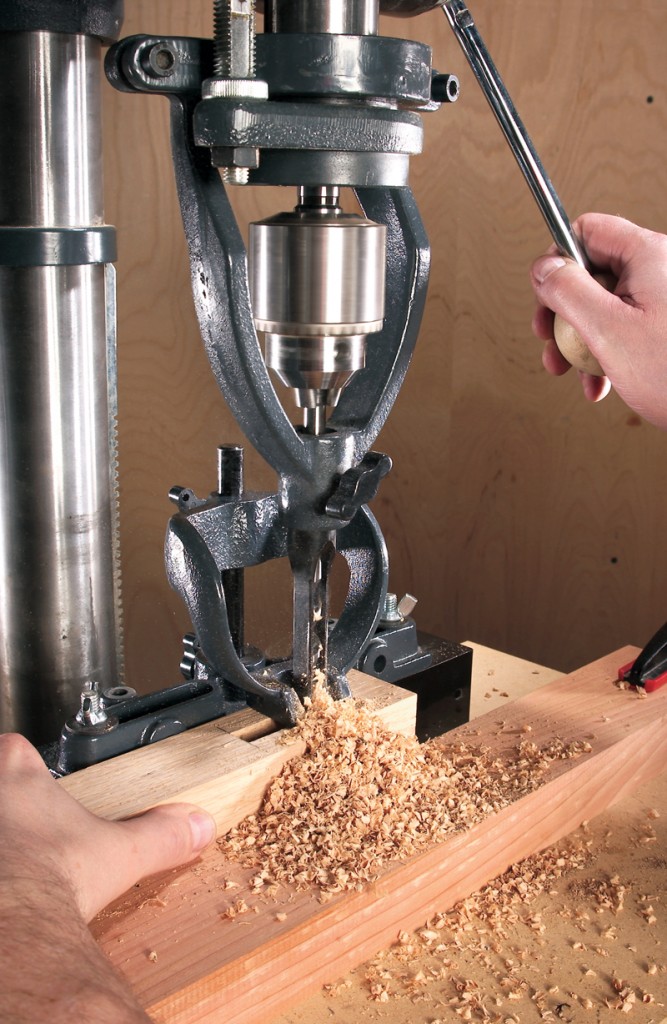If you’re wondering if you can use your drill press as a mortiser, you’ve come to the right place! Many DIYers and woodworkers have asked this very question, and today we’re going to explore the answer together. So, put on your safety goggles and let’s dive in!
Now, you might be thinking, what exactly is a mortiser? Well, it’s a specialized tool used in woodworking to create square or rectangular holes called mortises. These holes are essential for joinery, and a mortiser is specifically designed for this task. But can your trusty drill press do the job? Let’s find out!
Before we give a definitive answer, let’s examine the capabilities of a drill press and how they compare to a dedicated mortiser. By understanding their similarities and differences, we can determine if the drill press can serve as a suitable substitute. So, let’s get ready to drill down into the details!
While a drill press can be used as a makeshift mortiser, it’s important to consider a few factors. Firstly, make sure your drill press has enough power to handle the task. Use a mortising bit and secure your workpiece properly. Remember, a dedicated mortising machine is more precise and efficient. If you only have a drill press, take your time and follow best practices to achieve satisfactory results.

Can I Use My Drill Press as a Mortiser?
Drill presses and mortisers are both tools commonly used in woodworking projects. While a drill press is designed for drilling holes, a mortiser is specifically used for cutting square or rectangular mortises. Many woodworking enthusiasts often wonder if they can use their drill press as a mortiser, saving them the cost and space of investing in a separate machine. In this article, we will explore whether it is possible to use a drill press as a mortiser, the limitations and considerations involved, and alternative options for mortising.
Drill Press vs. Mortiser: Understanding the Differences
Before delving into whether a drill press can be used as a mortiser, it is important to understand the key differences between these two tools. A drill press, also known as a pedestal drill or bench drill, is primarily used for drilling repetitive, accurate, and straight holes in various materials such as wood, metal, and plastic. It consists of a motor, a chuck that holds the drill bit, and a spindle that raises and lowers to control the depth of the hole.
In contrast, a mortiser, also called a mortising machine, is specifically designed for cutting square or rectangular holes called mortises. It consists of a chisel and auger bit combination that removes the material to create the mortise. A mortiser often has a dedicated table, fence, and hold-down mechanism to ensure precise and controlled cuts. Mortisers are commonly used in woodworking projects that require joinery, such as making mortise and tenon joints.
While both tools involve drilling, the main difference lies in the types of holes they create. A drill press creates round holes, whereas a mortiser creates square or rectangular mortises. Additionally, the mortiser has specific features to ensure accuracy, stability, and consistency in the mortise cuts.
Can I Use a Drill Press as a Mortiser?
While it is technically possible to use a drill press for some light mortising tasks, it is not recommended or ideal. Drill presses lack the specific features and adjustments required for accurate and precise mortise cuts. Here are some limitations and considerations if you decide to use your drill press as a makeshift mortiser:
- Limited Depth Control: Drill presses have limited depth control compared to mortisers. Mortising often requires precise depth adjustments for different material thicknesses, which may not be easily achieved with a standard drill press. This can result in uneven and inconsistent mortises.
- Stability and Control: Mortising requires stability and control to create clean and accurate cuts. While a drill press does provide some level of stability, it may not offer the dedicated features, such as a hold-down mechanism and a mortising table, to ensure optimal control and precision.
- Chisel Compatibility: Drill presses typically use drill bits, which are not suitable for mortising. Mortising involves chisels and auger bits that are specifically designed for square or rectangular cuts. Trying to use a drill bit for mortising can lead to poor results, damaged bits, and potentially unsafe conditions.
Alternative Options for Mortising
If you frequently need to create mortises in your woodworking projects, it is highly recommended to invest in a dedicated mortising machine. A mortiser will provide the necessary features, stability, and control to ensure precise and consistent results. However, if space and budget constraints are a concern, here are a few alternative options:
- Hand Chisels and Mallet: Traditional hand tools, such as chisels and a mallet, can be used for creating mortises. While this method requires more effort and skill, it can be a cost-effective solution for occasional mortising needs.
- Drill Press Attachments: Some manufacturers offer mortising attachments that can be mounted onto a drill press, transforming it into a dedicated mortising machine. These attachments provide the necessary adjustments and features for mortising, but it is important to research and choose a reputable and reliable option.
- Oscillating Mortisers: Oscillating mortisers are small, portable machines that are specifically designed for light to medium-duty mortising tasks. These machines are compact and more affordable compared to traditional mortisers, making them suitable for hobbyists and those with limited space.
The Importance of a Dedicated Mortiser
While it may be tempting to try and use a drill press as a mortiser, the results will likely be subpar and inconsistent. A dedicated mortiser offers the necessary features, stability, and control to ensure precise and clean mortise cuts. Investing in a quality mortiser will save time, effort, and frustration in the long run, enabling you to create professional-quality joinery for your woodworking projects.
Key Takeaways: Can I Use My Drill Press as a Mortiser?
- While it is possible to use a drill press as a makeshift mortiser, it is not recommended for several reasons.
- A drill press lacks the necessary features and precision of a dedicated mortiser.
- Using a drill press for mortising can result in inaccurate and inconsistent cuts.
- Mortising requires specific tools and techniques that a drill press may not be designed for.
- Investing in a dedicated mortiser will ensure better results and safety when working on mortise and tenon joints.
Frequently Asked Questions
Have you ever wondered if you can use your drill press as a mortiser? Check out these commonly asked questions for answers.
Can I use my drill press for mortising?
While a drill press may seem similar to a mortiser, they are designed for different purposes. A drill press is primarily used for drilling holes, whereas a mortiser is specifically made for cutting square or rectangular holes called mortises. Using a drill press for mortising may result in inaccurate and imprecise cuts, as well as potential damage to the drill press itself. It is recommended to use a dedicated mortiser for optimal performance.
If you require mortising capabilities, investing in a mortiser will provide better results. A mortiser has unique features, such as a special chisel and bit, that are designed to create precise mortises. Additionally, mortisers usually have adjustable depth stops and fences that allow for accurate and repeatable cuts. By using the right tool for the job, you can ensure clean and professional-looking mortises.
What are the risks of using a drill press as a mortiser?
Using a drill press as a mortiser can pose several risks. First, the lack of proper chisels and bits designed for mortising may result in inaccurate and rough cuts that do not fit your intended joinery. The drill press may also lack features like adjustable depth stops and fences, making it challenging to achieve consistent and precise mortises.
Additionally, the forces involved in mortising are different from those in drilling, which can strain the drill press and potentially damage its components. The drill press may not be designed to handle the lateral forces applied during mortising, leading to decreased accuracy and safety hazards. To prevent these risks and ensure high-quality mortises, it is advisable to invest in a dedicated mortiser.
Can I modify my drill press to function as a mortiser?
While it may be tempting to modify your drill press to function as a mortiser, it is generally not recommended. Modifying power tools can compromise their functionality, safety, and warranty. The design and mechanics of a drill press are not optimized for mortising, and attempting to modify it can result in poor performance and potential damage.
If you require mortising capabilities, it is best to invest in a dedicated mortiser. Dedicated mortisers are built with the necessary features to ensure accurate and efficient mortise cutting. They often provide adjustable depth stops, fences, and specialized chisels and bits, all designed to deliver clean and precise mortises.
What are the benefits of using a dedicated mortiser instead of a drill press?
Using a dedicated mortiser offers several advantages over using a drill press for mortising. Firstly, a mortiser is purpose-built for cutting mortises, providing better accuracy and precision compared to a drill press. The specialized chisels and bits used in mortisers ensure clean and square-sided mortises, essential for strong joinery.
Additionally, dedicated mortisers usually feature adjustable depth stops and fences, allowing for consistent and repeatable cuts. The overall design and mechanics of a mortiser are optimized for mortising, providing a safer and more efficient woodworking experience. By choosing a dedicated mortiser, you can achieve professional-looking mortises and enhance the quality of your woodworking projects.
What other tools can I use for mortising besides a drill press?
Aside from a dedicated mortiser, there are alternative tools that can be used for mortising. One popular option is using a mortising attachment for a drill press. These attachments are specifically designed to convert a drill press into a mortiser by adding the necessary features, such as a chisel and bit. However, it’s important to note that the performance and accuracy of these attachments may vary.
Another tool that can be used for mortising is a hand-held or benchtop router equipped with a mortising bit. Routers can be highly versatile and offer precise control for creating clean and accurate mortises. However, using a router for mortising requires careful setup and operation, as it can be more challenging to achieve consistent results compared to dedicated mortising machines.

Summary
So, can you use your drill press as a mortiser? Well, it’s not the best idea. While they may look similar, drill presses and mortisers have some important differences. Unlike a drill press, a mortiser is specifically designed to make square holes for mortise and tenon joints. It has a chisel and bit that removes material in a controlled and precise way. Using a drill press in this way can be dangerous and may not give you the desired results. It is always best to use the right tool for the job to ensure safety and accuracy.
If you need to make square holes for woodworking projects, consider investing in a mortiser or exploring other methods like a chisel or a router. Your safety and the quality of your work are worth it. So, even though it may seem tempting to try and use your drill press as a mortiser, it’s best to resist the urge and stick to the right tool for the task at hand.
